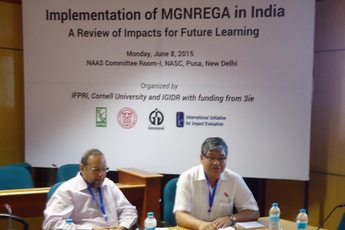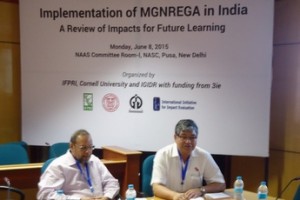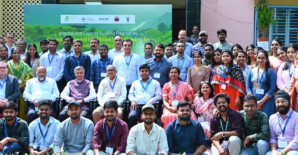Konark Sikka is an intern with IFPRI-South Asia office
It has now been a decade since the Mahatma Gandhi National Rural Employment Guarantee Act (MGNREGA) cleared the halls of Parliament. MGNREGA’s principal aim is to improve livelihoods, mostly in the rural areas, by guaranteeing 100 days of work every year. In a recent research study by the Indira Gandhi Institute for Development Research (IGIDR) and the International Food Policy Research Institute (IFPRI), the authors analyze the effect of this public works program, using a multitude of data collected between 2006 and 2012. The results were recently presented at “Implementation of MGNREGA in India - A Review of Impacts for Future Learning,” a seminar organized on June 8, 2015 by IGIDR and IFPRI in New Delhi.
In Andhra Pradesh, a leading example, the program instituted by MGNREGA, was found to have made a significant short term impact, especially in marginalized communities. Participants improved their caloric and protein intakes, with energy intake going up to 253 kilocalories (kcal) per day from 152 kcal per day prior to their participation. Protein intake, meanwhile, more than doubled from 2.07 grams per day to 5.80 grams per day.
In the medium term, participants’ non-financial assets, such as land, grew. In fact, in comparison with general castes, whose medium term effects were limited to increased consumption, scheduled castes and tribes had a better rate of improvement in both their energy intake and accruement of non-financial assets. There wasn’t a wage gap in terms of the wages that men and women received under MGNREGS and this has helped in women having a higher participation in comparison to men into the program.These outcomes overall indicated that MGNREGS is having a concentrated positive impact on marginalized groups, especially those who rely on casual labor.
The research points out that participation varied across states, ranging as low as 4 to 5 percent in Punjab, Haryana, and Maharashtra to rates as high as 89 percent in Mizoram. Part of this variation can be explained by the number of poorer households in the states, as well as participants self-selecting and opting into the program. For instance, 69 percent of rural households in Chhattisgarh opted for MGNREGS while just 20 percent of rural households participated in Haryana.
However, another reason for the variation is also how administrations ration—or in other words, assign jobs when there are more applicants than available work—to households in an economic strata. In Mizoram, the state with an 89 percent participation rate, there were only 4 percent jobs being rationed away from the poor. In states with low participation such as Punjab and Maharashtra, rationing amounted to 83 to 84 percent against the poor. Ideally there should be no rationing in an employment guarantee scheme, but the aim is to know if rationing is at least pro-poor. In any case, a poor household’s likelihood of seeking employment through MGNREGS is quite high, which suggests that the program’s self-targeting design is in itself pro-poor.
Delving further into the data showed five states which were exemplary when it came to allocating employment to the poorer sections who sought MGNREGS work: Manipur, Mizoram, Rajasthan, Sikkim, and Tripura. For instance, in Mizoram around 80 percent of households that sought work under MGNREGS were from among the poorest sections of the state and there were close to zero households being denied employment due to rationing, indicating an excellent pro-poor employment rate under MGNREGS in the state.
MGNREGS has encouraged significant participation of women in the work force, but women’s rate of participation across states is not consistent. Some states, such as Tamil Nadu (64.9%) and Kerala (85.2%), display a high rate of households sending only women to work under MGNREGS. Even at the all-India level, the proportion between households sending only women and households sending only men is relatively high. However, in other states, such as Bihar, Jammu & Kashmir, Odisha, Uttar Pradesh, and West Bengal, these rates are quite low. “Social barriers, a simple lack of awareness of the potential benefits of MGNREGS, no options for child care for young mothers, and a threat of harassment at work sites are few of the reasons for low participation,” said Sudha Narayanan, associate professor at IGIDR.
When it comes to avoiding or better managing rationing, states with poor records should look to follow the example set by the five states with a stellar record providing poorer people with employment under MGNREGS.
In states where women have lower accessibility to MGNREGS programs, efforts should be made to ensure that rationing of jobs isn’t biased against women. More efforts should be made in sensitizing staff and workers as well. There is a need to realize that each state should have a different policy when it comes to the issue, due to the variations in participation rates.
IGIDR Director, Dr. S Mahendra Dev said that policymakers need to continue to follow the two-fold strategy of letting the economy grow fast and attacking poverty directly through poverty alleviation programs that improves employment.




